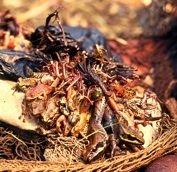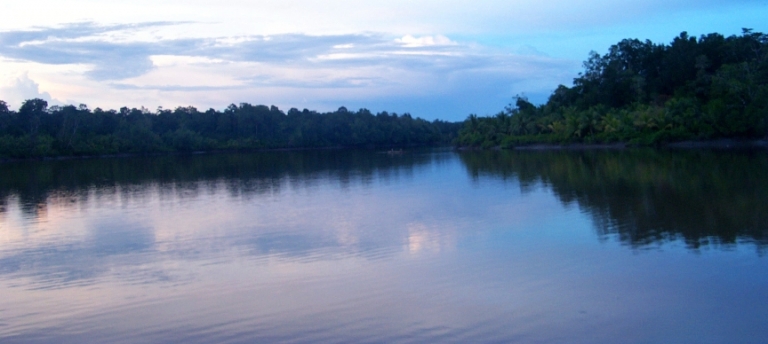
When I lived in West New Guinea — the Papua Province of Indonesia — I often flew in a Cessna, a single engine plane. I enjoyed it very much, especially if the pilot was rather “crazy” and flew low, following the contours of the rainforest below. My eyes were riveted on the landscape. His best maneuver was flying up along the slope of the mountains, passing the top, and flying down the slope on the other side. The tips of the trees atop the forest canopy were just 10 to 15 meters below us; the edge of the canopy umbrella was even closer, if we flew in, not over, the valleys. Sometimes, in response to my question—I always sat either next to or behind him—“what is that?,” he would flip the plane to the side I was pointing at. This would cause me to black out for a second before I saw “the what” better.
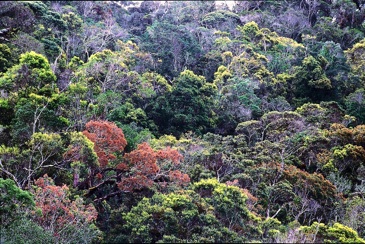
Colorful Canopies of Tropical Rainforest
The rainforest is layered from its top canopy 30 meters or more in height, interrupted by scattered emergent trees with umbrella-shaped crowns soaring over 50 meters, down through the middle trees spread raggedly below. The chaotic growth with its nuanced shades of green and colorful leaves and flowers create a complex mosaic of vegetation types.
Hundreds of tree species thrive within a few hundred square meters. Beauty arises from the chaos, a beauty very different from the one of neatly designed gardens of luxurious villas.
Accenting the scenic panorama are hundreds of birds from different flocks perching in or flying over the trees. The glittering waterfalls, hundreds of them ranging from a few to a hundred meters in height, are a stunning counterpart to the trees around them. The beauty of the rainforest fills one’s memory with peace and great awe.
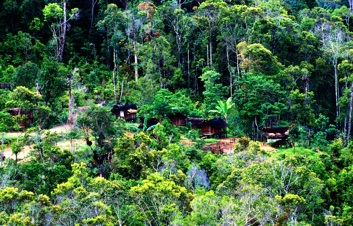
Tribal huts in the Papua jungle
In addition to animal species, Homo sapiens also live in the rainforest of Papua. These forest peoples have lived there for thousands of years. It is not so easy to see their hamlets from the sky because their little huts—thatched domes— blend in with the forest. Except at missionary stations, there are usually not more than five huts per hamlet.
Continuing on my flight, I watched the southern slope of the Central Cordillera drop steeply, from 3000 meters to just a few meters above sea level. Suddenly we were flying over the great green “carpet” that stretches hundreds of kilometers to the coast of the Arafura Sea. The trees are taller and bigger here, but the leaves are less colorful. The green landscape is actually like a jigsaw puzzle; brown lines separate the green “pieces.” The wide, winding rivers meander slowly to the south. From the sky, they look like gigantic crawling snakes. At intervals along these rivers, I could see groups of houses, the lowlander hamlets. These hamlets are easier to spot than the highlanders’ ones because there are usually more than ten houses per hamlet, and the houses—mostly square—are bigger.
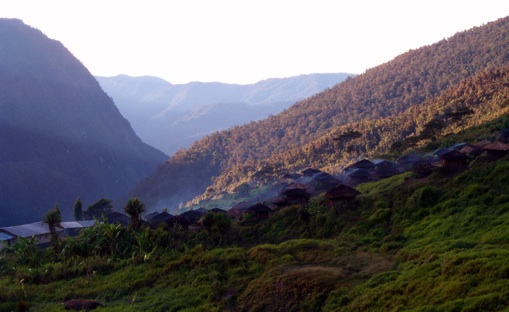
Smoky huts from cooking and baking breakfast in a traditional village of Papuans
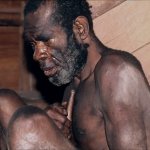
Under malaria attack
The rainforest kept my head moving in all directions. I was on a special mission this time. There had been a report of many deaths in the interiors and I suspected that malaria was the cause. El Nino in 1997 – 1998 increased the average air temperature and expanded the suitable habitat of the vector anopheline mosquitoes to a higher altitude. The district head of the Grand Valley of Baliem did not agree with my analysis and did not give me permission to visit the area. However, the missionaries supported me. We planned to fly me to an airstrip in the southern lowland outside the district. From there, I would then hike back to the highlands, and a Cessna would pick me up three weeks later.
This route was extremely difficult, according to the missionaries. There had only one non-papuan ever attempted this track, but from top to bottom. My challenge was to make the climb from bottom to top. The most attractive aspect of the trip was the opportunity to see the whole transect of rainforest in one trip: mangrove, lowland, submontane, montane and moss forests. The missionaries gave me medical supplies and US NAMRU (the United States Naval Medical Research Unit) provided me with survey equipment and material for malaria mapping.
The Cessna flew low over a hamlet and circled twice before landing on a grassy airstrip just a few meters from the bank of the local river. Within 15 minutes, the plane took off again, leaving me alone with the forest people of Siru. To them, I was an “exotic species.” I was the only person with straight hair, and my dark brown skin was the lightest among the 40- 50 people at the airstrip. However, my physical characteristics were not the only thing made them scrutinize me. I was the first medical doctor ever to visit Siru.
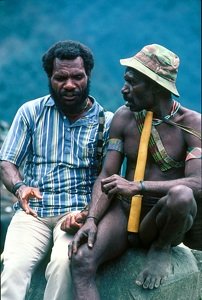
The same generation of a tribe but brought up in different civilizations
From the time I landed, I could tell that there were two distinct tribal groups in Siru (http://youtu.be/0vNN7_tDkBc). One group consisted of people with short stature, wide faces and flat noses; the other group was tall with relatively long faces and high noses. The first group were highlanders brought down by the missionaries about 15 years before; the second were the indigenous tribe. Both groups are descendants of the same ancestors who came to New Guinea from other parts of Asia thousands of years ago.
Rugged landscape and tribal wars have separated theses tribes for thousands of years. This long isolation has created distinct groups of people, not only between lowland and highland peoples but also among tribal groups in the same region. It is similar to the effect of island biogeography isolation on animal speciation.
The two groups in Siru were not only different physically, their lifestyle and clothes were different as well. Some of the highland men still wore penis gourds and of the women grass skirts. They planted food crops and vegetables around their houses and raised pigs. One house was usually occupied by 1 to 2 families. By contrast, all the lowland men wore shorts—usually dirty and torn—with no shirt; some of the women wore grass skirts, but of different style and material than of the highland women’s. No lowlander was engaged in cultivation; they were pure hunter-gatherers with their livelihood fully dependent on the forest.
The village was located at the bank of a river about 40 meters wide with a slow current Although Siru is about 70 kilometers away from the coast, the river was still affected by the tide, changing the direction of the flow twice a day. The rhythm of daily activities was regulated by this tide. Unless very necessary, the people never paddled their dugouts against the flow. The difference between the lowest and highest tides could be more than 1.5 meters, a bit shorter than the poles that supported the houses.
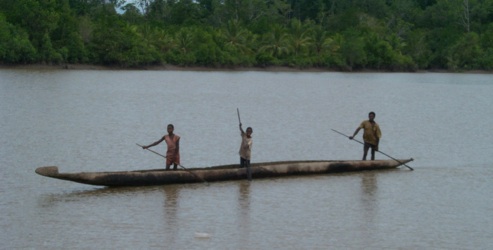
Forest people paddling dugout
During the day, the village was quiet. Except for the very sick, the lowlanders were in the forest. In the afternoon, dugouts came ashore and men jumped out armed with axes, leaving the women to unload food and firewood from the canoes. Each woman carried these supplies, along with a baby if she had one, back to the long houses. Then the village came alive with the voice of playing children. A few moment later, I could see the smoke of cooking fires rising from the roofs.
Sitting by the river watching the sunset, I saw the beauty of the forest come alive. As the sunlight faded, it created impressive tree silhouettes. In the sky hornbills, parrots, and cockatoos were flying across the river; some of them perching on the trees. The flapping of the hornbills was loud and they gave long, raucous cries as they flew by in groups. The funniest sound was that of the cockatoos, their voices reminding me of a conversation among children. The black ones, called king cockatoos, were not as noisy as but much more elegant and beautiful than the white ones. The noisiest birds of all were the parrots. Flying in groups as large as a hundred, their colors flashed red, green, yellow, and blue.
In the evening, all the highlander families in Siru could be found sitting by the fires in their kitchen huts. I joined them in burying sweet potatoes, taro (Colocasia esculenta), and plantains in the burning ash. These are the staple food of the highlanders, eaten together with boiled vegetables and grilled river fish—a delicious and nutritious dinner.
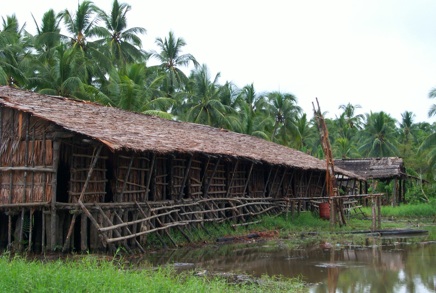
Lowlander’s bachelor house
The lowlander families were also sitting by the fire every evening, but not in the kitchen. Their long houses were shared by six to ten families; one fire per family. Their staple food was sago, the starch extracted from the trunk of the sago palm tree (Metroxylan). The extraction was done in the forest and took weeks of hard work. For the lowlanders, this was considered easier than planting sweet potato and taro and tending these crops for three to six months.
The sago was usually baked; sometimes cooked to be papeda, a sticky dough. Both versions were tasteless and low calorie. The lowlanders rarely ate vegetables; their diet consisted mainly of carbohydrate and protein. However, their protein source—fish and sago grubs—was much better than the highlander’s. The sago grub was harvested from the sago trunk after it had been cut, split, pounded, and left in the forest a few months before. The sago grubs were eaten alive or cooked—I have never been able to swallow a single wriggling grub!
I woke early in my first morning in Siru. I had to check everyone before they disappeared into the forest. But many children were already gathering in front of the house; each was holding a small plastic bag with yellow stuff inside; and I exchanged a balloon for a plastic bag. The bags contained stools, the “hotspot” of diverse species of parasites and bacteria; I had found a new species of worm once. I preserved the stools with formalin in small plastic tubes for identification by the NAMRU laboratory later on.
People were enthusiastic to be examined and to watch me working. Most of them decided to take a holiday from collecting food from the forest. I examined almost 100 people and took blood smears for malaria and filariasis (worms in the blood and lymph systems) from all of them. I also measured their hemoglobin level; the results were often depressing. The hemoglobin levels in all the children and women were subnormal; some young children’s were only 2 or 3 (normal being 11 to 15). These very anemic young people were pale and weak; their blood was diluted and transparent. It was just a miracle they were still alive. But most of these children would not survive to adulthood; they would become victims of malaria, hookworm, pneumoniae, and other communicable diseases.
The surviving ones did not developed optimally either. It was very clear that the highland children were more superior intellectually than the lowland ones when I had conversations with them; also, the body weight of most highland children were in normal range while all lowland children were below normal range for their height. But it is difficult to know what causes these differences; it could be chronic malnutrition, frequent sickness events, parenting method, genetics, or all of them.
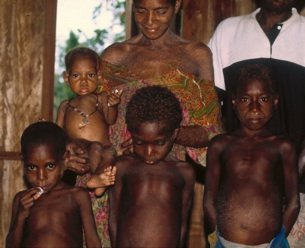
Mycosis is a common skin disease in the hot and humid of tropical rainforest; potbelly caused by both massive worm infections and enlarged spleen from malaria
I treated all the sick, but found this was not so easily done. My patients were not used to taking pills or taking syrup by themselves and I had to watch them carefully. As my syrup supply was limited, I had to split one bottle into some small plastic bags; each for one day. The instruction had to be clear in order to avoid drug overdose. Labeling plastic bags with pictures of sunrise, full sun, and moon was quite an effort. In the entire village, only the local preacher and his son could read Indonesian.
The preacher took me down the river in his motor dugout the following morning. We had to go south where the Siru river meet Suru-suru river and then returned north following that river. There were eight other people in the boat, highlanders who wanted to visit their home village in the highland. The boat moved slowly because the engine was only 15 horse power. I liked this slowness in the beginning, because I could see the trees, birds, and hanging bats clearly. However, as my buttock and legs started aching—the dugout was narrow and full of supplies and people—the slowness became torture.
We stopped at every village along the river that day, providing health service, and staying overnight in the last one. On day two, however, there was no village to stay in at the end of the day. This was not surprising, as the population density of the rainforest in Papua is much less than one person per square kilometer. Luckily, we found a bivouac before total darkness fell, and the forest people let us stay overnight. Travelling and staying in the boat was dangerous; the crocodiles that we saw during the day were active hunters at night.
The river became narrow and shallow when we were approaching foothills. At some places, the passengers had to leave the boat and walk along the bank because the engine was not powerful enough against the current. Moreover, bumping into the pebbles might turn the boat over. We had to turn off the engine and drag and push the boat. After two hours struggling with the current, the voice of children ahead was a beautiful melody to my ear. We reached Surusuru in time, before the darkness.
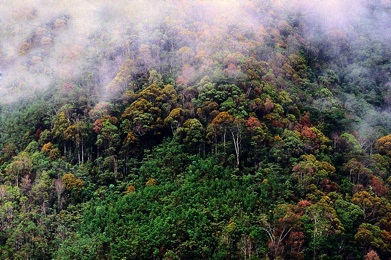
Cloud forest
We stayed three days in Suru-suru, the last village in the lowland. The river was no longer muddy, and I could explore the forest on foot. The walking was easy because the forest was still pristine. With a good flashlight, I could see three lower layers of the rainforest: highest were the understory trees, 15 to 20 meters high; next, shrubs, young trees, tall herbs and ferns; and lowest were tree seedlings and a few low herbs.
Across the layers, lianas (woody climbers that germinate in the understory), strangler vines, and creepers coiled around the tree trunks, dangling from high limbs all the way to the ground. In the places where there was enough sunlight glimmering through the canopy gaps, I could see a blend of the vividly green silhouettes of various ferns and the garden of colorful orchids spiraling among the high branches. Here and there—using a flashlight—I was amazed by the distinctive colors and shapes of flowers and fruits, and of various fungi growing on either the fallen trees or soil. When I looked at the forest floor, especially around the gigantic plank-like buttresses of roots, I was startled by the diverse crawling and jumping creatures living there: insects (mostly ants and beetles), spiders, frogs, lizards, snails, worms, leeches, millipedes, centipedes, scorpions, etc.
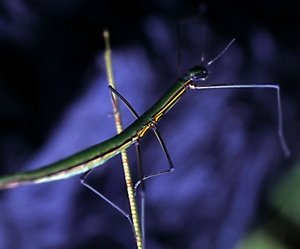
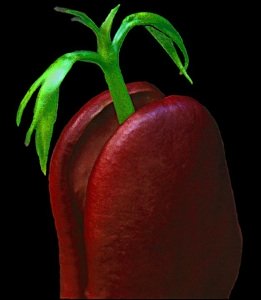
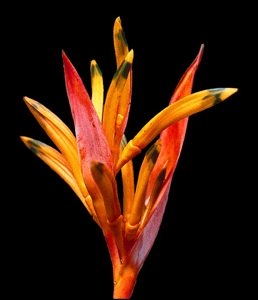
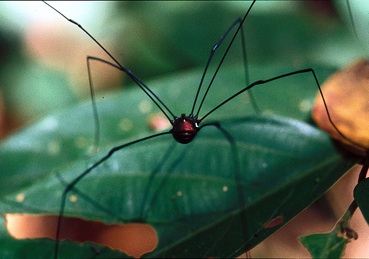
Our natural world is a thing of beauty largely because of the diversity of living forms found in it. The number and variety of the animals one can see in the rainforest depends on the time and place as well as the altitude. If you walk a hundred meters along the bank of a creek an hour after sunrise, you will see hundreds of different animals: flying arthropods including butterflies, damselflies, dragonflies; surfing water striders; web-spinning spiders; swimming fish and tadpoles; sitting frogs; basking monitor lizards; and brightly colored chirping birds. If you take a longer look, you might see chameleons or iguanas. With some extra luck, you might see monkeys, deer, crocodiles, snakes, or—in places like Sumatra and Borneo—elephants and orangutans.
It is estimated that one-half to two-thirds of all species of terrestrial plants and animals live in these rainforests. As compared to temperate deciduous forests where there are 5 to a maximum of 30 tree species per hectare, tropical rainforests may have 50-100 tree species per hectare. Alwyn Gentry (1988) recorded 283 tree species in one hectare of Peruvian rainforest; 63 percent of these were represented by a single tree. The number of animal species is much higher. Wilson (1987) found 43 species of ants belonging to 26 genera from a single leguminous tree in the Tambopata Reserve in Peru. The chances are high that you will find a new species or phenomenon within days or, if you work hard, within hours of your arrival in the rainforest (Wilson, 1992). So many kinds of plants and animals live in the rainforest, and we know so little about them:
About the orchids of that place we knew very little. About flies and beetles almost nothing, fungi nothing, most kinds of organisms nothing. Five thousand kinds of bacteria might be found in a pinch of soil, and about them we knew absolutely nothing. (the Diversity of Life, E.O. Wilson, 1992)
In spite of containing the largest diversity of species on Earth, tropical rainforests are unable to support the modern lifestyle and growing population of human beings. Food resources within the forest are extremely dispersed and what food does exist requires considerable energy to obtain.


